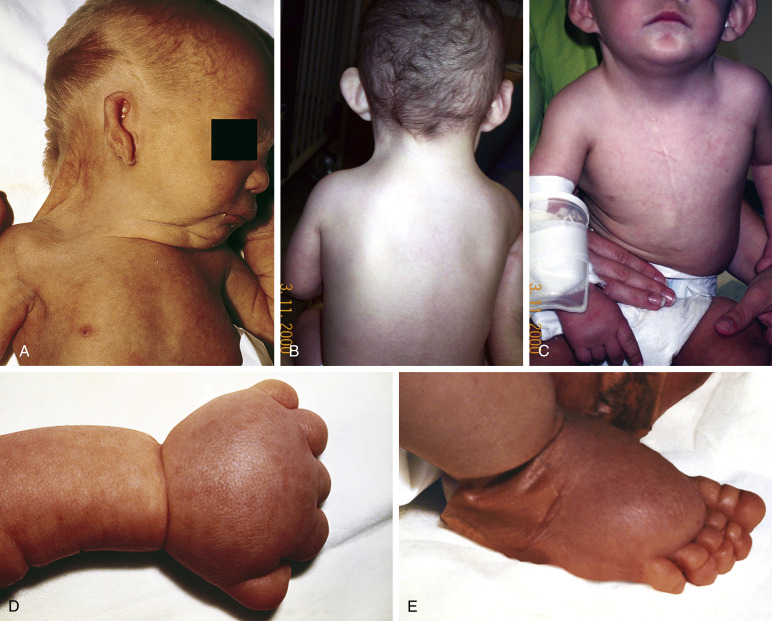AUTHOR: Fred F. Ferri, MD
Turner syndrome is a pattern of malformation characterized by short stature, ovarian hypofunction, loose nuchal skin, and cubitus valgus, as described by Turner in 1938. An associated 45,X chromosome constitution was recognized by Ford et al in 1959. Karyotypes discovered in subjects with phenotypic characteristics of Turner syndrome are described in Table E1.
TABLE E1 Karyotypes Discovered in Subjects With Phenotypic Characteristics of Turner Syndrome
| Karyotype | Error | ||
|---|---|---|---|
| 45,X | Deletion X | ||
| 45,Xi(Xq) | Deletion Xp, Isochromosome Xq | ||
| 45,X,Xq | Deletion Xp | ||
| 45,X/46,XX | Mosaicism | ||
| 45,X/46,XX/47,XXX | Mosaicism | ||
| 45,X/46,XY | Mosaicism | ||
| 45,X/46,XY/47,XYY | Mosaicism | ||
| 45,XringX | Ring chromosome | ||
| 46,XX | Phenotype with normal karyotype |
From Gershenson DM et al: Comprehensive gynecology, ed 8, Philadelphia, 2022, Elsevier.
| ||||||||||||
- Turner phenotype is recognizable at any point on the developmental spectrum.
- In spontaneous abortions, it is the most common sex chromosome abnormality detected (45,X chromosome constitution) and accounts for 20% of such cases.
- In fetuses, it is suspected when ultrasonographic manifestations such as thickening of the nuchal folds, frank nuchal cystic hygromas, or mild shortness of the femur at midtrimester are identified.
- In infants (Fig. E1):
- At birth may display loose nuchal skin (pterygium colli) and edema on the dorsa of hands and feet
- Canthal folds reflecting midface hypoplasia and redundant skin in the periorbital region
- Nipples appearing widely spaced (interthelial distance greater than one fourth the chest circumference)
- Heart and cardiovascular system: Murmur of aortic stenosis or bicuspid aortic valve or diminished femoral pulses suggestive of aortic coarctation
- Renal ultrasonography: Renal ectopia such as pelvic kidney or horseshoe kidneys
- In older children:
- Slow linear growth.
- Short stature: May be improved with growth hormone therapy. Combining childhood ultra-low-dose estrogen with growth hormone may improve growth and provide other potential benefits associated with early initiation of estrogen replacement.
- Delayed or absent menses: Secondary sex characteristics possibly normalized with estrogen replacement therapy.
- Intelligence is often normal, but delays in spatial perception or visual-motor integration are commonly observed; frank developmental impairment is rare.
A, This Newborn Shows a Webbed Neck with Low Hairline, Shield Chest with Widespread Nipples, Abnormal Ears, and Micrognathia. B, The Low-Set Posterior Hairline Can Be Better Appreciated in This Older Child, Who Also Has Protruding Ears. C, In This Frontal View, Mild Webbing of the Neck and Small, Widely Spaced Nipples are Evident, Along with a Midline Scar from Prior Cardiac Surgery. The Ears are Low Set and Prominent, Protruding Forward. D and E, The Newborn Shown in (A) Also Has Prominent Lymphedema of the Hands and Feet.
From Madan-Khetarpal S, Arnold G: Genetic disorders and dysmorphic conditions. In Zitelli BJ [eds.]: Zitelli and Davis’ atlas of pediatric physical diagnosis, ed 6, Philadelphia, 2012, Elsevier.
- Abnormal phenotype caused by absence of the second sex chromosome, whether X or Y
- 45,X chromosome constitution in approximately 50% of affected individuals
- Other chromosome aberrations (40% of cases): Isochromosome Xq (46,X,i[Xq]) or mosaicism (XX/X)
- With deletions involving the short (or “p”) arm of the X chromosome: Short stature but little ovarian hypofunction
- Deletions involving Xq13-q27: Ovarian failure
- Usually a deficiency of paternal contribution of sex chromosome, reflecting paternal nondisjunction
